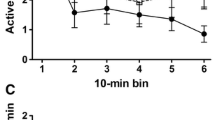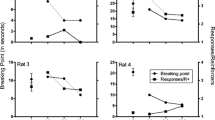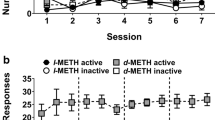Abstract
Rats were trained to respond to one of two levers under a random ratio schedule of food reinforcement. Which of the levers was correct was redetermined before each response and signalled by a light. The effects of d-amphetamine (0.2–3.2 mg/kg), chlordiazepoxide (1–8 mg/kg), and the neuroleptic alpha-flupenthixol (0.03–0.33 mg/kg) on the efficiency of rats tracking this visual cue were examined. d-Amphetamine increased the proportion of responses made on the correct lever at low and intermediate doses, but reduced the proportion at 3.2 mg/kg. At the highest dose, chlordiazepoxide produced a small increase in this measure, together with a reduction in response rate, but alpha-flupenthixol had no effect, even at a dose reducing response rate. Low doses of amphetamine also increased switching between the levers, producing a proportionately greater increase in switching from the correct lever to the incorrect lever than vice versa. The results are interpreted as showing that d-amphetamine facilitates tracking performance as a result of its action of enhancing response switching, and supporting the hypothesis that facilitation of performance by amphetamine-like drugs depends on the effect of the drug on response output coinciding with task requirements.
Similar content being viewed by others
References
Evenden JL (1983) A behavioural and pharmacological analysis of response selection. Unpublished PhD thesis, University of Cambridge
Evenden JL, Robbins TW (1983a) Dissociable effects of d-amphetamine, chlordiazepoxide and alpha-flupenthixol on choice and rate measures of reinforcement in the rat. Psychopharmacology 79: 180–186
Evenden JL, Robbins TW (1983b) Increased response switching, perseveration and perseverative switching following d-amphetamine in the rat. Psychopharmacology 80: 67–73
Gray JA (1977) Drug effects on fear and frustration. Possible limbic site of action of minor transquilisers. In: Iversen LL, Iversen SD, Snyder SH (eds) Handbook of psychopharmacology, Vol VIII. Plenum Press, New York, pp 433–529
Hill RT (1970) Facilitation of conditioned reinforcement as a mechanism of psychomotor stimulation. In: Costa E, Garattini S (eds) Amphetamine and related compounds. Raven Press, New York, pp 781–795
Katz JL (1982) Effects of drugs on stimulus control of behavior. I. Independent assessment of effects on response rates and stimulus control. J Pharmacol Exp Ther 223: 617–623
Kulig BM, Calhoun W (1972) Enhancement of successive discrimination reversal learning by methamphetamine. Psychopharmacologia 27: 233–240
Ksir C (1975) Scopolamine and amphetamine effects on discrimination: interaction with stimulus control. Psychopharmacology 43: 37–41
Laties VG (1972) The modification of drug effects on behavior by external discriminative stimuli. J Pharmacol Exp Ther 183: 1–13
Laties VG, Wood RW, Cooper Rees D (1981) Stimulus control and the effects of d-amphetamine in ther rat. Psychopharmacology 75: 277–282
Lyon M, Robbins TW (1975) The action of central nervous stimulant drugs: a general theory concerning amphetamine effects. In: Essman WB, Valzelli L (eds) Current developments in psychopharmacology, Vol. 2. Spectrum, New York, pp 80–163
Randrup A, Munkvad I (1970) Biochemical, anatomical and psychological investigations of stereotyped behaviour induced by amphetamines. In: Costa E, Garattini S (eds) Amphetamine and related compounds. Raven Press, New York, pp 695–713
Robbins TW (1976) Relationship between reward-enhancing and stereotypical effects of psychomotor stimulant drugs. Nature 264: 57–59
Robbins TW, Watson BA (1981) Effects of d-amphetamine on response repetition and win-stay behaviour in the rat. In: Bradshaw CM, Szabadi E, Lowe CF (eds) Quantification of steady-state operant behaviour. Elsevier/New Holland, Amsterdam, pp 441–444
Sacks O (1973) Awakenings. Duckworth, London
Sahakian BJ, Robbins TW (1975) The effects of test-environment and rearing condition on amphetamine-induced stereotypy in the guinea pig. Psychopharmacologia 45: 115–117
Valenstein ES, Myers WJ (1964) Rate-independent test of reinforcing consequences of brain stimulation. J Comp Physiol Psychol 57: 52–60
Weiss B, Laties VG (1962) Enhancement of human performance by caffeine and the amphetamines. Pharmacol Rev 14: 1–36
Winer BJ (1971) Statistical principles in experimental design, 2nd edition. McGraw-Hill, Kogagusha, Tokyo
Author information
Authors and Affiliations
Rights and permissions
About this article
Cite this article
Evenden, J.L., Robbins, T.W. The effects of d-amphetamine, chlordiazepoxide and alpha-flupenthixol on food-reinforced tracking of a visual stimulus by rats. Psychopharmacology 85, 361–366 (1985). https://doi.org/10.1007/BF00428202
Received:
Accepted:
Issue Date:
DOI: https://doi.org/10.1007/BF00428202




